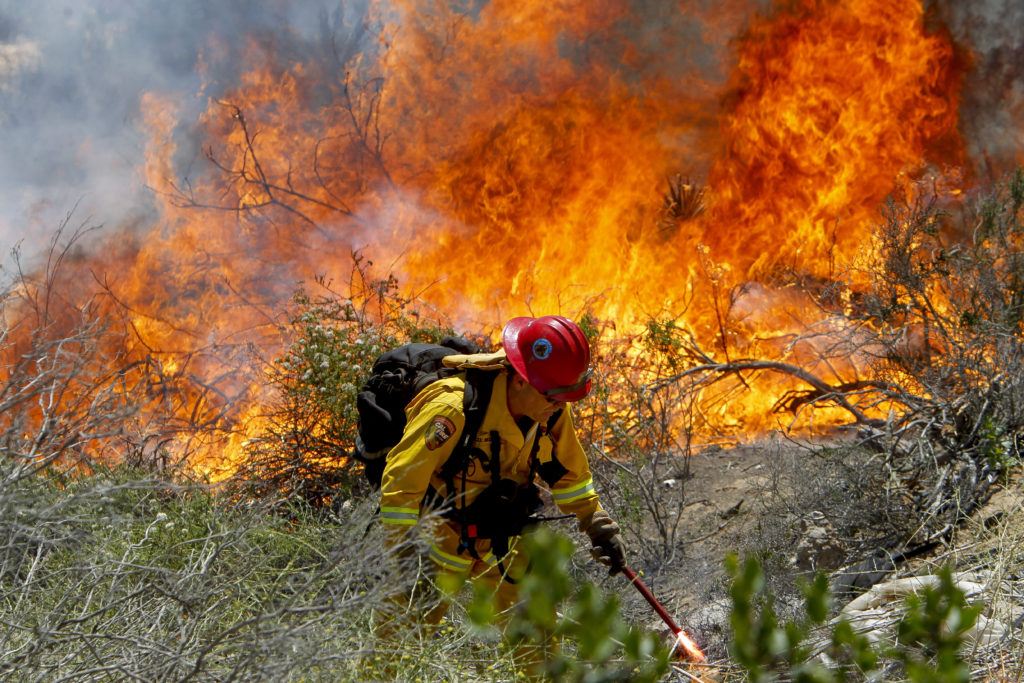California had long been a good bet for homeowners’ insurers, with most carriers having no problem recouping paid losses through premiums.
But in 2017 and 2018, the state experienced six of the 10 most destructive wildfires in its history and suffered total wildfire fire damages of nearly $25 billion. The state’s direct loss ratio for home insurers skyrocketed to an average of 179%, the highest of any major state, according to a new report by Moody’s Investor Services.
Moody’s says those damages are not a fluke. Global warming has made wildfires a “first tier peril,” on par with hurricanes and earthquakes, the ratings house said. As a result, insurers are imposing stricter underwriting standards, raising rates and dropping policies when they come up for renewal, forcing homeowners into the residual market.
“Several recent academic studies have concluded that wildfire exposure for the western US has increased in recent years because of drier forests, a longer burning season and higher average temperatures,” the report says. “As climate change continues to intensify, California could experience further heavy wildfire losses in the years ahead.”
Moody’s vice president Jasper Cooper said in an interview that before 2017, California typically experienced average direct loss ratios of up to 80%. But then came the Tubbs fire, which killed 22 people and caused $7 billion in insured losses in 2017. Two other fires that year killed five more and caused another $3.2 billion in damages. But that was just a warmup for 2018, when the Camp Fire destroyed most of the Sierra foothill town of Paradise, killing 85 and causing $8.7 billion in damages.
Licensed data provided by SNL Financial shows that in 2018 California emerged as the new leader for upside-down loss ratios among states with at least $500 million in direct written premium. Colorado, which suffered extensive hail damage, had a loss ratio of 129% and Florida, a perennial hurricane target, came in at 111% that year. No other state suffered a loss ratio of more than 100%.
The losses were not suffered evenly among carriers. Allstate racked up a loss and loss adjustment ratio of 271%, Farmers 243% and Travelers 226%, according to the SNL data. State Farm, which has the largest market share for homeowners insurance, had a loss ratio of 92%, while No. 5 ranked Auto Club’s loss ratio was only 55%.
The figures do not include any reinsurance recoveries.
Recouping Losses
Moody’s said historically, insurers have been able to recoup much of their wildfire losses through subrogation claims against utilities. Downed power lines caused at least three of the state’s 10 most destructive wildfires and California has a liberal inverse condemnation law that requires utilities to pay for any damages their equipment causes regardless of neglect.
But the bankruptcy of Pacific Gas & Electric has made those recoveries less certain in the future. Moody’s said State Farm, Allstate and USAA have filed lawsuits against PG&E seeking reimbursement for losses from wildfires that were sparked by its power lines. However: “Most insurers have not recorded subrogation recoverables from PG&E on their balance sheets because of uncertainty over collectability,” the Moody’s report says.
In response, insurers are limiting their exposure by declining to renew some policies, especially if they are overexposed in particular areas. Insurers are also getting stickier about their underwriting by conducting inspections and requiring homeowners to mitigate fire risk by clearing nearby brush, trees and debris.
Carriers are also raising rates, particularly in the “wildland-urban interface,” those bands around urban areas where homes are spread out amid sage-brush covered hills. However, California law restricts insurers’ ability to recover losses quickly.
Proposition 103, a 1988 ballot measure that sets out the rules for insurers in California, requires a public hearing for any personal lines increases of more than 7%. What’s more, insurers are required to spread the recovery of catastrophe losses over no less than a 20-year period, Moody’s said. Insurers are also prohibited from considering reinsurance costs in their rate filings and are not permitted to incorporate modeled wildfire losses. As a result, most rate increases will come in sequences of 6.9% or less, according to the report.
As carriers reduce their exposure, more homeowners are turning to the state’s residual market pool, called the California Fair Access to Insurance Plan. The FAIR Plan is a private organization to which all homeowner insurers in the state belong.
Moody’s said the FAIR Plan accounts for less than 1% of the California market, but it could grow significantly if the state suffers a third year of catastrophic wildfire losses. In February, the plan increased rates by 20% to address higher losses and the cost of repairs in wildfire areas. If the plan suffers large losses, it can assess property and casualty insurers based on their share of the homeowners’ and commercial property market, Moody’s said.
In some areas of California, homeowners are finding it difficult to find insurers willing to write them a policy.
Trying to Find Coverage
John Kiefer owns the Kiefer Insurance Agency in Groveland, a rural community about 30 miles from Yosemite National Park. He says he frequently gets non-renewal notices by homeowners’ insurers, and the news is sometimes hard to take. Kiefer said one homeowner who had been paying about $2,500 annually for a homeowner’s policy was quoted $15,000 for replacement coverage.
“They did not see this coming,” Kiefer said. “When Paradise and Redding, when all these places catch fire and have huge catastrophic losses, they may say, “Gee, I wonder what that’s going to do for their insurance rates,’ but they don’t apply it to themselves. They are not realizing that this is a statewide issue.”
Kiefer said even communities that enforce strict fire safety rules are not immune from raising rates and non-renewals. He says he lives just outside the gated Pine Mountain Lake gated community, which has fire hydrants spaced every 300 to 500 feet. The covenants, conditions and restrictions for the community require homeowners to clear all dry weeds and low branches from their properties. If they don’t, the homeowners’ association hires a contractor to do the work and sends the homeowner a bill.
Still, homeowners in Pine Mountain Lake are finding it difficult to find coverage. Kiefer said insurers don’t look past the Insurance Safety Office’s fire-severity rating for a property when deciding what rate should apply. He said in his opinion, the ISO’s system doesn’t fully take into account Pine Mountain Lake’s strict fire safety standards.
The Moody’s report points to some advances that might mitigate some of the impact of wildfires now being a Tier 1 catastrophe risk.
The two vendors that provide wildfire models have significantly updated their predictive analysis tools in the past year, and now reflect considerations such as fire clusters, wind and terrain, the report says. “With wildfires now a major catastrophe peril, we expect primary insurers and reinsurers to model wildfire risk, particularly in the western US, as they have historically done for hurricanes and earthquakes,” the report says. “These models will help insurers with exposure management and reinsurance purchases.”
In July, California Gov. Gavin Newsom signed legislation that establishes a wildfire fund of up to $21 billion that covers participating electric utilities. All three of the state’s investor-owned utilities — PG&E, Southern California Edison and San Diego Gas & Electric, have signed up. The fund will quickly pay insurer subrogation claims if insurers agree to settle their claims for 40 percent or less of their gross claims, according to the report. The money comes from a $10.5 billion contribution from the state treasury, a matching contribution by utilities and a surcharge on electric bills.
The fund pays claims when wildfire losses exceed the greater of the utility’s insurance coverage or $1 billion annually. But the legislation does not address the state’s inverse condemnation law, which PG&E blames for its bankruptcy. PG&E cannot assess the fund until it emerges from Chapter 11 proceedings and pays a $4.8 billion contribution.
Nonetheless, the report paints a dire picture.
“As climate change continues to intensify, California could experience further heavy wildfire losses in the years ahead,” the report says. “According to a recently published report by Earth’s Future, California experienced a five-fold increase in annual burned area since the early 1970s, likely driven by climate change, with average summer temperatures increasing by about 1.4°C (2.5°F) and drier atmospheric conditions.”
Was this article valuable?
Here are more articles you may enjoy.


 Cyberattack Surge Creates Opportunity, Premium Rethink for Insurers
Cyberattack Surge Creates Opportunity, Premium Rethink for Insurers  Mattel Settles Baby Sleeper Death Suits Before Start of a Trial
Mattel Settles Baby Sleeper Death Suits Before Start of a Trial  Chinese Hacked US Telecom a Year Before Known Wireless Breaches
Chinese Hacked US Telecom a Year Before Known Wireless Breaches  Cars Are Getting Smarter. Why It Matters for Claims Professionals
Cars Are Getting Smarter. Why It Matters for Claims Professionals 